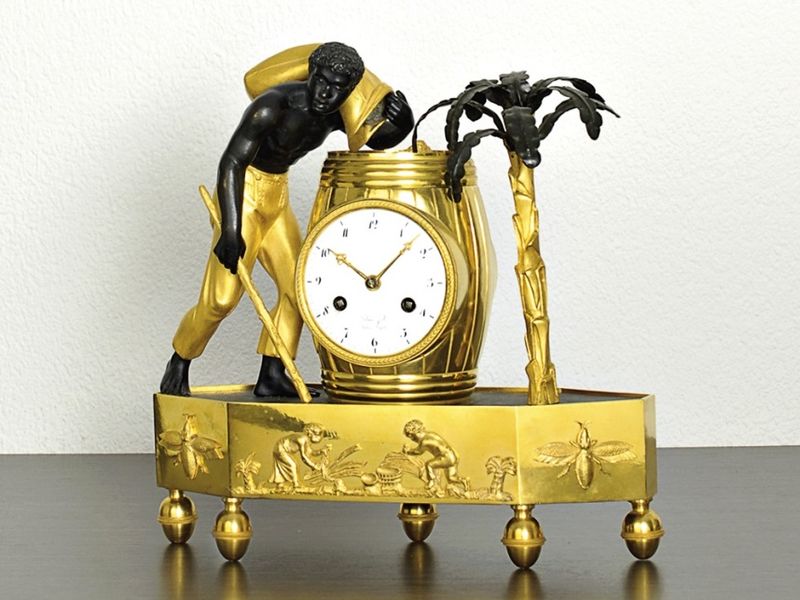Datei:Blanc Fils Palais Royal, Paris Pendule Au Bon Sauvage, circa 1810 (1).jpg

Originaldatei (858 × 643 Pixel, Dateigröße: 162 KB, MIME-Typ: image/jpeg)
Blanc Fils Palais Royal, Paris, 290 x 290 x 10 mm, circa 1810

|
Alle Bildrechte liegen bei dem Auktionshaus Auktionen Dr. H. Crott. Diese Abbildung ist urheberrechtlich geschützt und steht nicht unter einer freien Lizenz. Für anderweitige Nutzungen außerhalb von Watch-Wiki ist die schriftliche Zustimmung des Urheberrechtsinhabers nötig. |
Bedeutende Directoire "Pendule Au Bon Sauvage" aus vergoldeter und patinierter Bronze mit Halbstunden/Stundenschlag "Der Kaffeebohnensammler - Allegorie des Fleißes"
Geh.: Bronze, feuervergoldet und patiniert, achteckiger Sockel mit reliefierter figürlicher Darstellung, Kugelfüße. Ziffbl.: Email. Werk: rundes Messing-Vollplatinenwerk, 1 Hammer / 1 Glocke, Hakenhemmung, Schlossscheibe, Fadenaufhängung.
Auf einem achteckigen Sockel mit reliefierten Darstellungen zweier Männer bei der Feldarbeit und seitlichen Abbildungen zweier Bienen, erhebt sich die dunkel patinierte Figur eines Mannes. Aus einem geschulterten Sack leert er Kaffeebohnen in ein großes Fass, das von einem exotischen Baum mit grün patinierten Blättern flankiert wird.
Eine nahezu identische Pendule ist abgebildet und beschrieben in Elke Niehüser, "Die Französische Bronzeuhr", München 1997, Seite 156.
Brian Loomes führt auf Seite 78 Blanc Fils in Paris, Palais Royal in der Zeit zwischen 1807 und 1825 auf.
An important Directoire gilt and patinated bronze "Pendule Au Bon Sauvage" with half hour/hour strike "The Coffee Bean Collector - Allegory of Diligence" Case: firegilt and patinated bronze, octagonal base with figural depiction in high relief, ball feet. Dial: enamel. Movm.: circular brass full plate movement, 1 hammer / 1 bell, anchor escapement, count wheel, silk string suspension.
An octagonal base with relief ornamentation shows two men working the fields on the front and two bees on the side panels; the base supports the dark figure of a man. He tips coffee beans from a sack on his shoulder into a large barrel standing next to an exotic tree with large, greenish leaves.
An almost identical pendulum clock is illustrated and described in "Die Französische Bronzeuhr" (French bronze clocks) by Elke Niehüser, Munich 1997, page 156.
Brian Loomes lists Blanc Fils in Paris, Palais Royal on page 78 for the period 1807 to 1825.
In the 18th and 19th century, Europeans were fascinated by all things exotic. There were several reasons for this; the philosophical essays by Jean-Jacques Rousseau, the literary works "Paul et Virginie" by Bernardin de Saint-Pierre, "Atala" by Chateaubriand and of course "Robinson Crusoe" by Daniel Defoe played an important role, as they developed the idea of the "noble savage". Travel diaries by explorers and conquerers of far away continents such as as James Cook also supported the image of the indigenous savage living a life uncorrupted by civilization - an image that greatly inspired the artists at the time. At the end of the Ancien Régime in the last decade of the 18th century, clockmakers created the first models that idealised the romantic idea of the noble savage and the Paradise lost. The motif is used with approximately 30 models and a nearly equal number of variations. Bronze artists at the time loved to emphasise the marvelous contrast of the dark and light surfaces - a dark skin tone with gold-coloured accessories. The most famous maker of this kind of bronze work was Jean Simon Deverberie (1764-1824). Today, we are equally fascinated and troubled by these pendulum clocks. One cannot deny the quality and the exotic beauty of the clocks but nevertheless there is a feeling of unease too because the motifs could be interpreted as discrimination on the basis of race. Ultimately, they are portraits of the wistful longing for harmony and freedom people felt at the Time of Enlightenment.
Dateiversionen
Klicke auf einen Zeitpunkt, um diese Version zu laden.
| Version vom | Vorschaubild | Maße | Benutzer | Kommentar | |
|---|---|---|---|---|---|
| aktuell | 11:49, 16. Mai 2020 |  | 858 × 643 (162 KB) | Andriessen (Diskussion | Beiträge) | Blanc Fils Palais Royal, Paris, 290 x 290 x 10 mm, circa 1810 {{Bildrechte U|dem Auktionshaus Auktionen Dr. H. Crott}} {{Kategorie Bildgalerie Uhrenmodelle Blanc Fils, Palais Royal}} Bedeutende Directoire "Pendule Au Bon Sauvage" aus vergoldeter un… |
Du kannst diese Datei nicht überschreiben.
Dateiverwendung
Die folgende Seite verwendet diese Datei:
- Bildgalerie Uhrenmodelle Blanc Fils, Palais Royal
- Picture gallery watch models Blanc Fils, Palais Royal
- Galería de imagenes de modelos de relojes Blanc Fils, Palais Royal
- Afbeeldingen galerij uurwerkmodellen Blanc Fils, Palais Royal
- Фотогалерея Модели часов Blanc Fils, Palais Royal
- Galleria fotografica di modelli orologi Blanc Fils, Palais Royal